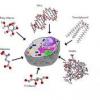糖皮质激素高敏感综合症
糖皮质激素高敏感综合症
(glucocorticoid hypersensitivity syndromes)
糖皮质激素高敏感综合症(glucocorticoid hypersensitivity syndromes)是近年来新发现的一种代谢类疾病,最初是发现它与Ⅰ型人获得性免疫缺陷病病毒(HIV-Ⅰ)的感染相关。HIV-Ⅰ长末端重复序列(LTR)与糖皮质激素反应性启动子共用同样的激动子,所以HIV-Ⅰ的附属蛋白Vpr和Tat可以同时刺激HIV-Ⅰ的长末端重复序列和糖皮质激素可诱导基因,前者可直接导致病毒增殖,而后者则通过糖皮质激素介导的机制抑制寄主的免疫系统从而间接地增强病毒增殖。有研究认为,糖皮质激素高敏感综合症也可能是由于肥胖症相关的胰岛素抵抗有关的代谢综合症引起并发症,这一并发症也被认为与病毒的感染有关1-3。
由Ⅰ型艾滋病毒引起的艾滋病人常常会显示一些与糖皮质激素受体活性增强相关的并发症,比如:先天的或T细胞介导的Ⅰ型细胞免疫的降低;肌肉消瘦、肌病;血脂障碍;肥胖症相关的胰岛素抵抗等,这些症状也同时出现于糖皮质激素过量分泌的患者中3-9。因此,很可能有一些未知的因子在调控艾滋病人的糖皮质激素受体的功能。
有体外实验证明,Vpr,一个96个氨基酸构成的,多功能的,HIV-Ⅰ相关蛋白可以通过它的共激动子功能提高糖皮质激素受体的转化活性10-12。事实上,Vpr在它的64-68氨基酸残基上含有一个核受体识别信号LXXLL,宿主的核受体共激动子可通过它结合到核受体上13。Vpr可通过核受体识别信号LXXLL直接结合到糖皮质激素受体上,并提高寄主的p160和p300/CBP提高启动子的反应活性12。Vpr还可以结合到p300的C末端,这个位置也是寄主的激动子p160蛋白的结合位点,发挥接头和共激动子复合物的作用14。由于Vpr在Ⅰ型艾滋病人体内是可以检测得到的,而且还可以穿过细胞膜,所以它的作用也许可以延伸到没有感染到HIV的细胞中15-16。通过细胞外给予Vpr可以激活糖皮质激素受体从而抑制外周单核细胞产生白介素12,可能就是HIV-Ⅰ感染的艾滋病人先天和细胞免疫抑制的一个原因17。
Tat,另一个HIV-Ⅰ相关蛋白,它可以作为一个主要的HIV-Ⅰ长末端重复序列启动子的反式作用元件,通过促进正性转录延伸因子b(positive transcription elongation factor b,P-TEFb)的蓄积适度增强糖皮质激素受体的活性3,18,9,19-22。与Vpr类似,Tat也可以轻易地穿过细胞膜,从而对未感染HIV的细胞发挥作用23。
1. T. Kino, G.P. Chrousos, Glucocorticoid and mineralocorticoid resistance/hypersensitivity syndromes, J. Endocrinol. 169 (2001) 437–445.
2. G.P. Chrousos, The role of stress and the hypothalamic–pituitary–adrenal axis in the pathogenesis of the metabolic syndrome: neuroendocrine and target tissue-related causes, Int. J. Obes. 24 (2000) S50–S55.
3. T. Kino, G.P. Chrousos, Acquired immunodeficiency syndromerelated insulin resistance and lipodystrophy: a multifactorial viral and iatrogenic condition, Endocr. Pract. 7 (2001) 480–484.
4. D.M. Simpson, A.N. Bender, Human immunodeficiency virusassociated myopathy: analysis of 11 patients, Ann. Neurol. 24 (1988) 79–84.
5. D.P. Kotler, K. Rosenbaum, J. Wang, R.N. Pierson, Studies of body composition and fat distribution in HIV-infected and control subjects, J. Acquir. Immune. Def. Syndr. Hum. Retrovirol 20 (1999) 228–237.
6. J.A. Yanovski, K.D. Miller, T. Kino, T.C. Friedman, G.P. Chrousos, C. Tsigos, J. Falloon, Endocrine and metabolic evaluation of human immunodeficiency virus-infected patients with evidence of protease inhibitor-associated lipodystrophy, J. Clin. Endocrinol. Metab. 84 (1999) 1925–1931.
7. C. Hadigan, K. Miller, C. Corcoran, E. Anderson, N. Basgoz, S. Grinspoon, Fasting hyperinsulinemia and changes in regional body composition in human immunodeficiency virus-infected women, J. Clin. Endocrinol. Metab. 84 (1999) 1932–1937.
8. M.P. Dube, Disorders of glucose metabolism in patients infected with human immunodeficiency virus, Clin. Infect. Dis. 31 (2000) 1467–1475.
9. T. Kino, M. Mirani, S. Alesci, G.P. Chrousos, AIDS-related lipodystrophy/insulin resistance syndrome, Horm. Metab. Res. 35 (2003) 129–136.
10. G.N. Pavlakis, The molecular biology of HIV-1, in: V.T. DeVita, S. Hellman, S.A. Rosenberg (Eds.), AIDS: Diagnosis, Treatment and Prevention, Raven, Philadelphia, 1996, pp. 45–74.
11. M. Emerman, HIV-1, Vpr and the cell cycle, Curr. Biol. 6 (1996) 1096–1103.
12. T. Kino, A. Gragerov, J.B. Kopp, R.H. Stauber, G.N. Pavlakis, G.P. Chrousos, The HIV-1 virion-associated protein vpr is a coactivator of the human glucocorticoid receptor, J. Exp. Med. 189 (1999) 51–62.
13. C. Leo, J.D. Chen, The SRC family of nuclear receptor coactivators, Gene 245 (2000) 1–11.
14. T. Kino, A. Gragerov, O. Slobodskaya, M. Tsopanomichalou, G.P. Chrousos, G.N. Pavlakis, Human immunodeficiency virus type-1 (HIV-1) accessory protein Vpr induces transcription of the HIV-1 and glucocorticoid-responsive promoters by binding directly to p300/CBP coactivators, J. Virol. 76 (2002) 9724–9734.
15. D.N. Levy, Y. Refaeli, R.R. MacGregor, D.B. Weiner, Serum Vpr regulates productive infection and latency of human immunodeficiency virus type 1, Proc. Natl. Acad. Sci. U.S.A. 91 (1994) 10873–10877.
16. P. Henklein, K. Bruns, M.P. Sherman, U. Tessmer, K. Licha, J. Kopp, C.M. de Noronha, W.C. Greene, V. Wray, U. Schubert, Functional and structural characterization of synthetic HIV-1 vpr that transduces cells, localizes to the nucleus, and induces G2 cell cycle arrest, J. Biol. Chem. 275 (2000) 32016–32026.
17. M. Mirani, I. Elenkov, S. Volpi, N. Hiroi, G.P. Chrousos, T. Kino, HIV-1 protein Vpr suppresses IL-12 production from human monocytes by enhancing glucocorticoid action: potential implications of Vpr coactivator activity for the innate and cellular immunity deficits observed in HIV-1 infection, J. Immunol. 169 (2002) 6361–6368.
18. T. Kino, G.P. Chrousos, Glucocorticoid and mineralocorticoid resistance/hypersensitivity syndromes, J. Endocrinol. 169 (2001) 437–445.
19. K.T. Jeang, H. Xiao, E.A. Rich, Multifaceted activities of the HIV-1 transactivator of transcription, Tat. J. Biol. Chem. 274 (1999) 28837–28840.
20. T. Kino, O. Slobodskaya, G.N. Pavlakis, G.P. Chrousos, Nuclear receptor coactivator p160 proteins enhance the HIV-1 long terminal repeat promoter by bridging promoter-bound factors and the Tat-P-TEFb complex, J. Biol. Chem. 277 (2002) 2396–2405.
21. D.H. Price, P-TEFb, a cyclin-dependent kinase controlling elongation by RNA polymerase II, Mol. Cell. Biol. 20 (2000) 2629–2634.
22. T. Kino, J.B. Kopp, G.P. Chrousos, Glucocorticoids suppress human immunodeficiency virus type-1 long terminal repeat activity in a cell type-specific, glucocorticoid receptor-mediated fashion: direct protective effects at variance with clinical phenomenology, J. Steroid Biochem. Mol. Biol. 75 (2000) 283–290.
23. S. Fawell, J. Seery, Y. Daikh, C. Moore, L.L. Chen, B. Pepinsky, J. Barsoum, Tat-mediated delivery of heterologous proteins into cells, Proc. Natl. Acad. Sci. U.S.A. 91 (1994) 664–668.
TAG:
标题搜索
日历
|
|||||||||
| 日 | 一 | 二 | 三 | 四 | 五 | 六 | |||
| 1 | 2 | 3 | 4 | 5 | 6 | ||||
| 7 | 8 | 9 | 10 | 11 | 12 | 13 | |||
| 14 | 15 | 16 | 17 | 18 | 19 | 20 | |||
| 21 | 22 | 23 | 24 | 25 | 26 | 27 | |||
| 28 | 29 | 30 | |||||||
我的存档
数据统计
- 访问量: 23511
- 日志数: 217
- 文件数: 60
- 建立时间: 2010-01-17
- 更新时间: 2012-03-28

